Examples of machine learning and deep learning are all around us. When you imagine how Facebook can recognize if the person in the photo is the legit owner or the emerging self-driving cars or how Netflix can make predictions of movies, you cannot avoid the two topics. Artificial intelligence is a rather wide subject, and therein is Machine Learning. In fact, do not worry if you are already finding it confusing. We all were at some point. Now let’s simplify this by breaking it down for you.
As much as many people find themselves using the terms machine learning and deep learning interchangeably, the two terms are desperate and do not really mean the same thing. So, then what is the difference between them?
Difference between machine learning and deep learning
You are actually right to call deep learning machine learning. However, it is more than that. Machine Learning evolved into these complex and dense networks that could make more informed and accurate decisions with minimal human intervention. This is the deep learning we are talking about. It is basically neural networks with several layers, some hidden, and goes very deep, making them extremely extensive and powerful. This came in with more capabilities than it had initially been anticipated. As a result, it took machine learning capabilities to a whole new level.
For those of you wondering, “you just said machine learning evolved into deep, dense neural networks called deep learning,” but you haven’t told me what machine learning is, don’t worry, I still have you in mind.
The definition of machine learning
Machine learning is simply a collection of algorithms that can handle data, carry out analysis on the same data and subsequently use various approaches to put what they have learned into practice so that eventually they can draw conclusive and meaningful decisions from the data it was initially presented with.
Still, confused?
Let’s look at the examples where machine learning is being used so that you can create a co-relation and better understand the concept of machine learning.
First, we will look at an e-commerce platform, for instance, Amazon. The platform has the ability to track what you buy over time, co-relate with people making similar purchases, and offer recommendations on what is new or trending that might catch your interest.
In a similar way, Movie vendors Netflix uses the same approach to offer recommendations to clients on the kind of movies that is likely to be something that interests them.
The recommender system making the suggestions has an inference engine that is able to make the deductions and subsequently offer curated suggestions as alternatives for you.
The capabilities of machine learning are simply unmatched. As a result, the automation benefit has been applied to various domains in various industries, including medicine, finance, software development, natural language processing, education, and security, among other domains.
For instance, in the service industry, there has been a growing number of virtual assistants used in different platforms to offer end-user support.
Such a platform is PayPal.
The Virtual aid can answer queries about the platform or their services and every time learns and becomes better. It is intelligent enough to recognize when the client is not satisfied with their answers; thus, it can recommend a human assistant when that arises.
Now, this concept about machine learning developing itself and improving over time sets it at another level altogether compared to other technologies invented in the recent past. This whole idea puts data at the center of machine learning.
You ask why?
Because data is the oil of machine learning, machine learning functions are applied to data to derive meaning from data. Over a series of doing this time and again, the machine learning algorithm becomes better progressively.
The early you get to understand neural networks, deep neural networks, and deep learning, the better your chances of comprehending learning in machines.
What are the differences between Machine Learning and Deep Learning?
Always remember that deep learning evolved from machine learning, and there is a thin line differentiating the two. So you need to be very careful less you see no difference.
The obvious differentiating factor between machine learning and deep learning is the idea of the hardware used in each case. Simple low-end hardware can function sufficiently for basic machine learning algorithms.
However, in the case of deep learning, hardware with better capabilities is highly required. For example, Graphical Processing Units are very handy when training a deep learning algorithm.
Example for illustration
Despite the tremendous growth in machine learning, it still requires human intervention.
For instance, if you have a machine learning gadget that takes orders from clients for some service, over time, it might recognize any phrase with the word “hello” as some sort of salutation from the client. Such is a traditional machine learning model. It is not very accurate.
However, a model based on the deep learning concepts can use its own “brain” to know that other terms like “hi,” “how are you” can be used interchangeably with the term initially used. This idea of self-learning is what differentiates deep learning from machine learning algorithms. It gives deep learning capabilities that are way beyond the imagination of the human mind.
The training period of a basic machine learning algorithm is brief. In fact, you can get it done in seconds, a few minutes, or some hours.
However, in the case of deep learning, the training periods can be very extensive in some cases. The latter is attributed to the number of complex computations that occur during deep learning.
Further, there are a lot of extensive calculations that take place when a deep learning algorithm is being trained. This can make it even take weeks or months to train a deep learning model.
The functioning of deep learning
Deep learning algorithms are layered structures that mimic the human brain’s function called the neural network. The inspiration derived from the neural network led to the formation of artificial neural networks that is the driving force behind the concept of deep learning.
Despite the hype on deep learning, it requires a lot of training to get it to do what is needed in the right manner. This can be a nightmare sometimes. However, the efforts put into training will pay off handsomely when it does. In fact, the capabilities are far from what anybody could ever anticipate.
Then to sum it all is the self-learning by these categories of algorithms. The ability to curate data, perform analysis, draw conclusions and learn from it and apply it to its functioning is what puts deep learning algorithms on a whole new level.
That is what separates the traditional or the naïve machine learning algorithms from deep learning algorithms.
Differences in application of machine learning and deep learning
Based on the nature and dynamism of the two algorithms, they do find application in areas that are a little different.
For example, deep learning is widely applicable in areas that require facial recognition, the recommendation of services, for example, movies by Netflix, and services involving streaming of music. The latest and trendiest application of deep learning is in cars that self-drive.
Many layers of dense neural networks are used to identify the finite details in some of these applications, for example, determining when to slow down or when to accelerate. What do you think is the concept used to avoid knocking down objects by self-driving vehicles? The answer is simple. It is deep learning at its best.
On the other hand, simple machine learning algorithms find use in programs that are predictive, for example, forecasting extreme weather changes like the hurricane and predicting fluctuations in the financial stoke markets. Besides, there is the case of email filtering to cluster mails as either spam or not. Also, there is a case of treatment evidence-based for sick persons where the design and the program all rely on machine learning.
Conclusion
This article has extensively given a brief introduction to what machine learning and deep learning are as well as critically highlighting the differences between the two.
Do not forget that deep learning evolved from machine learning and has grown into a structural framework with many layers whose computational capabilities are unmatched. As a result, deep learning finds use in the complex areas of our day-to-day activities that require a lot of computation with precise accuracy levels. Such areas include image recognition and recommender systems.
On the other hand, basic machine learning algorithms are useful in applications such as forecasting the weather, finances, and evidence-based medical treatment.
We are hopeful that you have been informed and that this article will get you started on a new path to using one of the two core concepts of artificial intelligence. There are other diverse fields in the machine that are also worth exploring. These include natural language processing, reinforcement learning, speech recognition, tensor flow, and computer vision. Do not hesitate to jump into those because it is not doubted that machine learning is a whole in the future.







